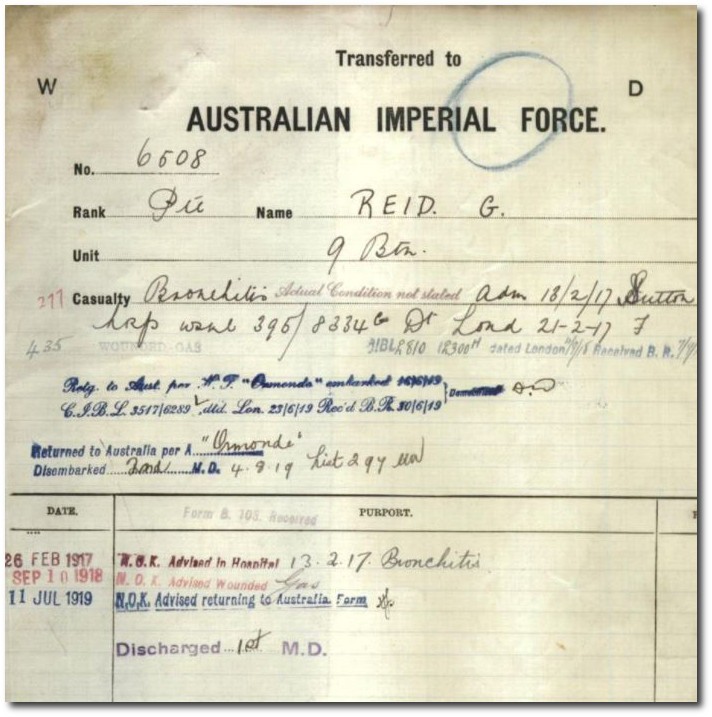
Extract from service record, for George Reid, courtesy of the National Archives of Australia, Series B2455 Item ID 8027752
Indigenous Australian, George Reid, 9th Infantry Battalion
George Reid of the Gudgal people was born in Hughenden in 1889 and worked as a stockman near Charters Towers. When he volunteered for the first AIF in June 1916, he named his sister Lily Peachey of Prairie, as his next of kin. Reid trained in Brisbane, before being allocated to the 21st Reinforcements for the 9th Infantry Battalion. These men from all over Queensland and northern NSW departed from Brisbane aboard the troopship ‘Boonah’ in October 1916 arriving six weeks later in England.
Not long after arriving in camp, Reid was taken ill and admitted to the military hospital. Several weeks later his illness, at first diagnosed as bronchitis, manifested as mumps. He rejoined the reinforcements in camp at the end of March and by May was fit to embark for France and the front lines.
He was one of 120 men who joined the 9th Battalion at Bapaume, under the command of Lieutenant Colonel Mullen, bringing up the strength of the battalion to a total of 41 officers and 800 other ranks. The battalion had just come out of the front lines, where they had carried out an attack on the Hindenburg Line.
They spent the next four weeks training and returning to strength, and on 31 July 1917 they received orders to begin an attack that became known as the Battle of Passchendaele. Conducted under appalling conditions, and resulting in tremendous loss of life, the Battle continued through until November.
In December 1917 George Reid was admitted to hospital with a painful infection known as ‘Cellulitis’ of the knee. He was treated for this condition several times, then in March 1918 was granted two weeks leave in England. A week after his return from leave he was found to be AWOL and ordered to be confined to barracks for 5 days (Field Punishment No.2). He repeated the offence two months later, and again confined to barracks for several days.
By August 1918 the battalion was fighting the Germans at Vaire Wood. On the 23rd they moved off at 2.30am to reach their trenches before the enemy barrage commenced. They reached their objective and by the end of the day had captured 110 prisoners, but there were many casualties. The Germans had conducted a terrific barrage of explosive and mustard gas shells, George Reid was one of those affected.
At first he was taken to one of the Field Ambulances for treatment, then on to several Casualty Clearance Stations, before being considered fit enough to return to his unit in September 1918. He remained with the 9th Battalion as the war came to an end and they waited to be returned home from their billets in Belgium.
George Reid eventually returned to Australia aboard HMAT Ormonde arriving in Queensland in August 1919. George continued to work as a stockman in the Maranoa district, his children and grandchildren remember him as a hardworking man, who received little or no recognition for his service to country; George died in February 1962 at Battery Station Homestead, north of Charters Towers.
Read more ...
- Service record: REID, George
- Embarkation roll: 21st Reinf. 9th Infantry Battalion
- Koori Mail Profiles of Stolen Wages claimants [pdf]
- One of the soldiers featured in SLQ’s HistoryPin Collection
Watch ...
- Queensland’s Indigenous Servicemen [digital story and oral history, 12 min, mp4]
The information in this blog post has been researched by State Library staff and volunteers, it is based on available information at this time. If you have more information that you would like to share or further research uncovers new findings, this post will be updated.
Comments
Your email address will not be published.
We welcome relevant, respectful comments.